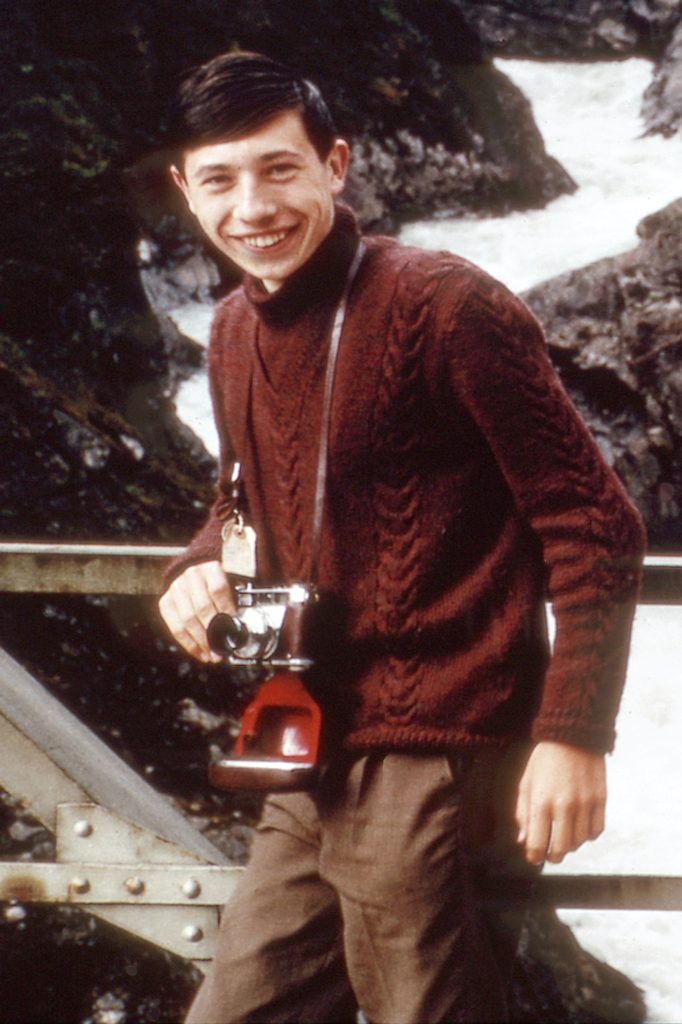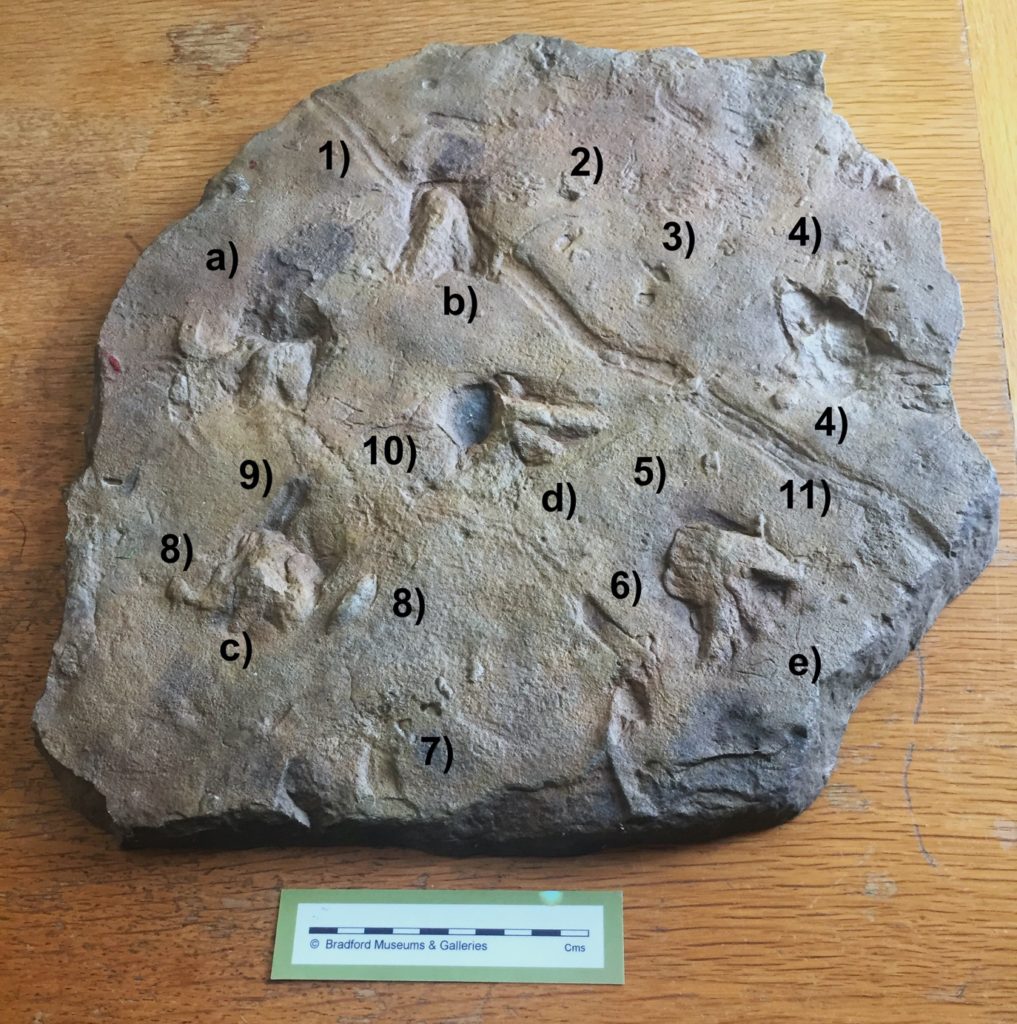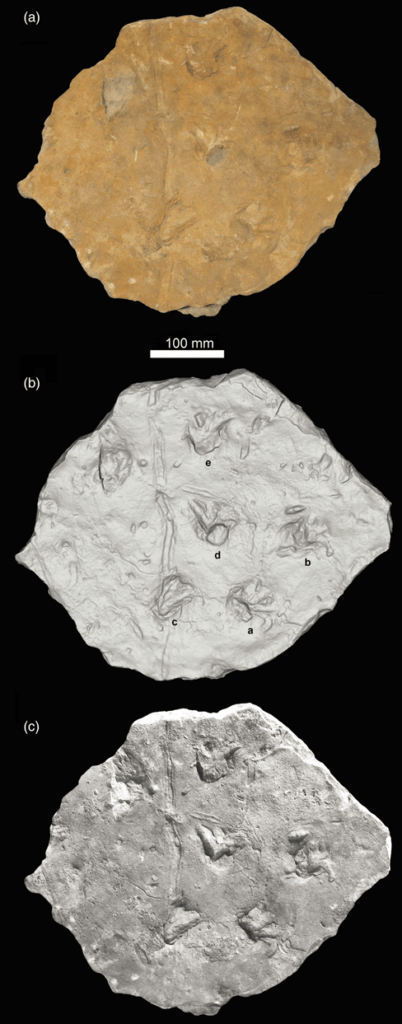Today’s blog has been written by our Curator of Collections, Dr Gearoid Mac a’ Ghobhainn and is all about fossils. He writes:
A recent acquisition to Bradford Museums & Galleries was the donation of a fibreglass cast of fossil footprints that was found in Wensleydale North Yorkshire. This is an exceptionally important acquisition because it shows the oldest currently know footprints of a tetrapod, a four-legged animal, that were made around 340 million years ago.
History of the fossil discovery
This fossil itself was discovered in 1966-67 by then schoolboy and keen fossil collector John Chapman

John was a pupil at Bell Vue Grammar School for Boys at the time and was taken on a field trip to Hardraw Force in Wensleydale, North Yorkshire by his then Geology teacher Mr Stuart Maude (Fig. 2 Map showing location of Hardraw Force where the important fossil was discovered).
While prospecting the area for some fossils John discovered a slab with strange imprints in it which were recognised as possible footprints by a long extinct creature. The slab of sandstone was removed and taken back to school for closer examination. John kindly gifted the specimen to his teacher Mr Maude who used it in future geology classes.

In 1977 Mr Maude decided he wanted to know more about the fossil footprints so he sent it down to London to be examined by palaeontologists at the Natural History Museum. It was there that Dr Angela Milner examined the ichnofossil (trace fossil), this is a fossil containing trace signs of footprints or impressions left behind by animals or plants. Dr Milner recognised the importance of the specimen and asked that it be donated to the museum for fuller study. Mr Maude agreed to the donation to Natural History Museum and in return received a very fine fibreglass cast that the museum technicians made of the original trace fossil (ichnofossil) (Fig. 3 Photo showing fibreglass cast of fossil).

Mr Maude then used this fossil cast in his geology classes for the remainder of his career. He even loaned the cast to other local geology teachers who also used it in their geology classes at their schools. So, over the careers of these local geology teachers many thousands of local schoolchildren will have had the opportunity to see this specimen close up and learn about its ancient origins.
Mr Maude recently contacted the museum to offer the specimen to us as a gift so that it could be used further to illuminate the past to visitors to the museum. We are always grateful to generous donations to our collections that can tell interesting and important stories about the local history of the region.
The fossil cast was accepted as a very important specimen that can inform about the prehistoric origins of life in the area. It was lying on a desk in the curator’s office when a museum volunteer popped in to talk with the curator. The volunteer recognised the fossil having seen it many years ago. The volunteer was John Chapman who explained how he had discovered the fossil when he was a schoolboy. John is currently retired and volunteers at Cliffe Castle Museum one day per week helping to update the records of our minerals collections. How fantastic it was for him to be reunited with one of his early fossil finds. John and Mr Maude also reconnected again after the story of its deposit in the museum was explained.
Recent Study
Recently, a new study was carried out on the original fossil at the Natural History Museum in London led by Dr Hannah Bird and Dr Angela Milner. In November 2019, a new publication of this research went to print in the Journal of the Geological Society. This up-to-date study describes the five footprints as belonging to a very ancient early tetrapod called Palaeosauropus sp.
The scientific name means Ancient Lizard Foot. This prehistoric animal is classified as a temnospondyl amphibian. This group of very early tetrapods had a manus (hand or forefoot) with four fingers/toes and a pes (hind foot) with five toes. The toes on both fore and hind feet are relatively short and stubby.

In addition to the tetrapod footprints recorded on the slab there are several other imprints of invertebrate trace fossils. In total, there are 11 different genera of trace fossil. These include a range of behaviours such as surface grazing by a wormlike animal (Gordia), locomotion by worms, arthropods and brachiopods (seashell molluscs), burrowing by worms etc
Importance of the fossil
This ichnofossil is a very important specimen of both national and international importance. The footprints recorded on the slab are the earliest known footprints of a four-legged animal that walked on Earth at around 340 million years ago during the lower Carboniferous Period. The transition from fish to earliest tetrapod vertebrates (animals with a backbone and four limbs) that crawled from the sea occurred only 20-30 million years earlier.
At the time this fossil footprint was made in the lower Carboniferous period (Visean) Yorkshire would have been located in the southern hemisphere in shallow tropical waters. The landscape would have been significantly different from Yorkshire today. During the Carboniferous, global temperatures were warmer, oxygen levels were also higher. The area that is now Yorkshire would have been wide tropical river deltas close to shallow tropical seas that occasionally swamped the land. These changing conditions laid down the rock layers that make of the Yorkshire landscape today, the sandstones from the river deltas, the coal measures from the tropical forests, and the mudstones from the times when sea levels rose to cover the river deltas and low lying land. Over tens of millions of years, through continental drift, Yorkshire, England and the rest of Europe, has slowly moved northwards to its current position.
Trace fossils like footprints can provide palaeontologists with invaluable information about long extinct animals. Unlike fossil skeletons and shells, which help scientists, piece together what the animal might look like in life, a trace fossil like a footprint records otherwise hidden information about an animal’s behaviour. They can inform us how an animal stood and bore its bodyweight, how it moved by walking gait, running speed etc. Although initially trace fossils may not seem as exciting a find as a skeleton they provide the evidence of how animals moved and interacted with their environments and thus help add essential details of how animals lived many millions of years ago.
On this fossil slab in addition to the very important footprints of Palaeosauropus there are numerous other creatures like worms, snails and seashells (brachiopods) (See Fig. 3). These trace fossils help build up a picture of the varied animal life that would have been around and by inference the plants too that may have been the food sources of these creatures.
References
A lower Carboniferous (Visean) tetrapod trackway represents the earliest record of an edopoid amphibian from the UK. Hannah C. Bird, Angela C. Milner, Anthony P. Shillito and Richard J. Butler. Journal of the Geological Society, 12 December 2019